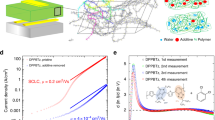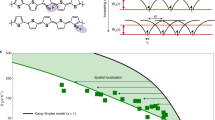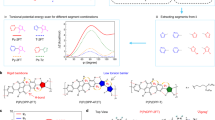Abstract
It is commonly assumed that charge-carrier transport in doped π-conjugated polymers is dominated by one type of charge carrier, either holes or electrons, as determined by the chemistry of the dopant. Here, through Seebeck coefficient and Hall effect measurements, we show that mobile electrons contribute substantially to charge-carrier transport in π-conjugated polymers that are heavily p-doped with strong electron acceptors. Specifically, the Seebeck coefficient of several p-doped polymers changes sign from positive to negative as the concentration of the oxidizing agents FeCl3 or NOBF4 increase, and Hall effect measurements for the same p-doped polymers reveal that electrons become the dominant delocalized charge carriers. Ultraviolet and inverse photoelectron spectroscopy measurements show that doping with oxidizing agents results in elimination of the transport gap at high doping concentrations. This approach of heavy p-type doping is demonstrated to provide a promising route to high-performance n-type organic thermoelectric materials.
This is a preview of subscription content, access via your institution
Access options
Access Nature and 54 other Nature Portfolio journals
Get Nature+, our best-value online-access subscription
$29.99 / 30 days
cancel any time
Subscribe to this journal
Receive 12 print issues and online access
$259.00 per year
only $21.58 per issue
Buy this article
- Purchase on Springer Link
- Instant access to full article PDF
Prices may be subject to local taxes which are calculated during checkout





Similar content being viewed by others
Data availability
Source data for Figs. 2–5 are provided with this paper. Additional data are available from the corresponding author upon reasonable request.
References
Bolto, B. A., McNeill, R. & Weiss, D. E. Electronic conduction in polymers. III. Electronic properties of polypyrrole. Aust. J. Chem. 16, 1090–1103 (1963).
Chiang, C. K. et al. Electrical conductivity in doped polyacetylene. Phys. Rev. Lett. 39, 1098–1101 (1977) ; erratum 40, 1472 (1978).
Joo, J. et al. Charge transport of the mesoscopic metallic state in partially crystalline polyanilines. Phys. Rev. B 57, 9567–9580 (1998).
Mateeva, N., Niculescu, H., Schlenoff, J. & Testardi, L. R. Correlation of Seebeck coefficient and electric conductivity in polyaniline and polypyrrole. J. Appl. Phys. 83, 3111–3117 (1998).
Shirakawa, H., Louis, E. J., MacDiarmid, A. G., Chiang, C. K. & Heeger, A. J. Synthesis of electrically conducting organic polymers: halogen derivatives of polyacetylene, (CH)x. J. Chem. Soc. D 16, 578–580 (1977).
Park, Y. W., Lee, Y. S., Park, C., Shacklette, L. W. & Baughman, R. H. Thermopower and conductivity of metallic polyaniline. Solid State Commun. 63, 1063–1066 (1987).
Wang, Z. H., Li, C., Scherr, E. M., MacDiarmid, A. G. & Epstein, A. J. Three dimensionality of “metallic” states in conducting polymers: polyaniline. Phys. Rev. Lett. 66, 1745–1748 (1991).
Lee, K. et al. Metallic transport in polyaniline. Nature 441, 65–68 (2006).
Bubnova, O. et al. Semi-metallic polymers. Nat. Mater. 13, 190–194 (2013).
Wang, S., Ha, M., Manno, M., Frisbie, C. D. & Leighton, C. Hopping transport and the Hall effect near the insulator–metal transition in electrochemically gated poly(3-hexylthiophene) transistors. Nat. Commun. 3, 1210 (2012).
Chance, R. R., Brédas, J. L. & Silbey, R. Bipolaron transport in doped conjugated polymers. Phys. Rev. B 29, 4491–4495 (1984).
Zuppiroli, L., Bussac, M. N., Paschen, S., Chauvet, O. & Forro, L. Hopping in disordered conducting polymers. Phys. Rev. B 50, 5196–5203 (1994).
Yoon, C. O. et al. Hopping transport in doped conducting polymers in the insulating regime near the metal–insulator boundary: polypyrrole, polyaniline and polyalkylthiophenes. Synth. Met. 75, 229–239 1995).
Zuo, F., Angelopoulos, M., MacDiarmid, A. G. & Epstein, A. J. Transport studies of protonated emeraldine polymer: a granular polymeric metal system. Phys. Rev. B 36, 3475–3478 (1987).
Tanaka, H. et al. Thermoelectric properties of a semicrystalline polymer doped beyond the insulator-to-metal transition by electrolyte gating. Sci. Adv. 6, eaay8065 (2020).
Hundley, M. F., Adams, P. N. & Mattes, B. R. The influence of 2-acrylamido-2-methyl-1-propanesulfonic acid (AMPSA) additive concentration and stretch orientation on electronic transport in AMPSA-modified polyaniline films prepared from an acid solvent mixture. Synth. Met. 129, 291–297 (2002).
Holland, E. R. & Monkman, A. P. Thermoelectric power measurements in highly conductive stretch-oriented polyaniline films. Synth. Met. 74, 75–79 (1995).
Thomas, E. M., Popere, B. C., Fang, H., Chabinyc, M. L. & Segalman, R. A. Role of disorder induced by doping on the thermoelectric properties of semiconducting polymers. Chem. Mater. 30, 2965–2972 (2018).
Venkateshvaran, D. et al. Approaching disorder-free transport in high-mobility conjugated polymers. Nature 515, 384–388 (2014).
Hwang, S. et al. Solution-processed organic thermoelectric materials exhibiting doping-concentration-dependent polarity. Phys. Chem. Chem. Phys. 18, 29199–29207 (2016).
Liu, J. et al. N-type organic thermoelectrics of donor–acceptor copolymers: improved power factor by molecular tailoring of the density of states. Adv. Mater. 30, 1804290 (2018).
Yoon, C. O., Reghu, M., Moses, D., Cao, Y. & Heeger, A. J. Thermoelectric power of doped polyaniline near the metal–insulator transition. Synth. Met. 69, 273–274 1995).
Brault, D., Lepinoy, M., Limelette, P., Schmaltz, B. & Van, F. T. Electrical transport crossovers and thermopower in doped polyaniline conducting polymer. J. Appl. Phys. 122, 225104 (2017).
Liang, Z. et al. Influence of dopant size and electron affinity on the electrical conductivity and thermoelectric properties of a series of conjugated polymers. J. Mater. Chem. A 6, 16495–16505 (2018).
Fritzsche, H. A general expression for the thermoelectric power. Solid State Commun. 9, 1813–1815 (1971).
Xu, B. & Verstraete, M. J. First principles explanation of the positive Seebeck coefficient of lithium. Phys. Rev. Lett. 112, 196603 (2014).
Rowe, D. M. (ed.) CRC Handbook of Thermoelectrics 1st edn (CRC Press, 1995).
Winkler, S. et al. Probing the energy levels in hole-doped molecular semiconductors. Mater. Horiz. 2, 427–433 (2015).
Png, R.-Q. et al. Madelung and Hubbard interactions in polaron band model of doped organic semiconductors. Nat. Commun. 7, 11948 (2016).
Heimel, G. The optical signature of charges in conjugated polymers. ACS Cent. Sci. 2, 309–315 (2016).
Chen, Y., Yi, H. T. & Podzorov, V. High-resolution ac measurements of the Hall effect in organic field-effect transistors. Phys. Rev. Appl. 5, 034008 (2016).
Yi, H. T., Gartstein, Y. N. & Podzorov, V. Charge carrier coherence and Hall effect in organic semiconductors. Sci. Rep. 6, 23650 (2016).
Podzorov, V., Menard, E., Rogers, J. A. & Gershenson, M. E. Hall effect in the accumulation layers on the surface of organic semiconductors. Phys. Rev. Lett. 95, 226601 (2005).
Houzé, E., Nechtschein, M. & Pron, A. Fixed-spin-induced ESR linewidth and polaron mobility in conducting polymers. Phys. Rev. B 56, 12263–12267 (1997).
Elliott, R. J. Theory of the effect of spin-orbit coupling on magnetic resonance in some semiconductors. Phys. Rev. 96, 266–279 (1954).
Zozoulenko, I. et al. Polarons, bipolarons, and absorption spectroscopy of PEDOT. ACS Appl. Polym. Mater. 1, 83–94 (2019).
Scholes, D. T. et al. The effects of crystallinity on charge transport and the structure of sequentially processed F4TCNQ-doped conjugated polymer films. Adv. Funct. Mater. 27, 1702654 (2017).
Jacobs, I. E. et al. Polymorphism controls the degree of charge transfer in a molecularly doped semiconducting polymer. Mater. Horiz. 5, 655–660 (2018).
Zhao, Y. et al. Conjugation-break spacers in semiconducting polymers: impact on polymer processability and charge transport properties. Macromolecules 48, 2048–2053 (2015).
Schroeder, B. C. et al. Taming charge transport in semiconducting polymers with branched alkyl side chains. Adv. Funct. Mater. 27, 1701973 (2017).
Luo, X. et al. Bis-isoindigos: new electron-deficient building blocks for constructing conjugated polymers with extended electron delocalization. Asian J. Org. Chem. 7, 2248–2253 (2018).
Boehm, A. M., Wieser, J., Butrouna, K. & Graham, K. R. A new photon source for ultraviolet photoelectron spectroscopy of organic and other damage-prone materials. Org. Electron. 41, 9–16 (2017).
Liang, Z., Boland, M. J., Butrouna, K., Strachan, D. R. & Graham, K. R. Increased power factors of organic–inorganic nanocomposite thermoelectric materials and the role of energy filtering. J. Mater. Chem. A 5, 15891–15900 2017).
Podzorov, V., Pudalov, V. M. & Gershenson, M. E. Field-effect transistors on rubrene single crystals with parylene gate insulator. Appl. Phys. Lett. 82, 1739–1741 (2003).
Choi, H. H. et al. Accurate extraction of charge carrier mobility in 4-probe field-effect transistors. Adv. Funct. Mater. 28, 1707105 (2018).
Cordischi, D., Occhiuzzi, M. & Dragone, R. Quantitative EPR spectroscopy: comparison between primary standards and application to MgO-MnO and α-Al2O3-Cr2O3 solid solutions. Appl. Magn. Reson. 16, 427–445 (1999).
Eaton, G. R, Eaton, S. S, Barr, D. P. & Weber, R. T. Quantitative EPR (Springer-Verlag, 2010).
Shen, X., Hu, W. & Russell, T. P. Measuring the degree of crystallinity in semicrystalline regioregular poly(3-hexylthiophene). Macromolecules 49, 4501–4509 (2016).
Frisch, M. J. et al. Gaussian 16 rev. C.01 (Gaussian Inc., 2016).
Hariharan, P. C. & Pople, J. A. The influence of polarization functions on molecular orbital hydrogenation energies. Theor. Chim. Acta 28, 213–222 (1973).
Perdew, J. P., Burke, K. & Ernzerhof, M. Generalized gradient approximation made simple. Phys. Rev. Lett. 77, 3865–3868 (1996).
Vreven, T., Frisch, M. J., Kudin, K. N., Schlegel, H. B. & Morokuma, K. Geometry optimization with QM/MM methods II: explicit quadratic coupling. Mol. Phys. 104, 701–714 (2006).
Vydrov, O. A. & Scuseria, G. E. Assessment of a long-range corrected hybrid functional. J. Chem. Phys. 125, 234109 (2006).
Vydrov, O. A., Scuseria, G. E. & Perdew, J. P. Tests of functionals for systems with fractional electron number. J. Chem. Phys. 126, 154109 (2007).
Francl, M. M. et al. Self‐consistent molecular orbital methods. XXIII. A polarization‐type basis set for second‐row elements. J. Chem. Phys. 77, 3654–3665 (1982).
Stein, T., Kronik, L. & Baer, R. Reliable prediction of charge transfer excitations in molecular complexes using time-dependent density functional theory. J. Am. Chem. Soc. 131, 2818–2820 (2009).
Cheema, H. et al. Near-infrared-absorbing indolizine-porphyrin push–pull dye for dye-sensitized solar cells. ACS Appl. Mater. Interfaces 11, 16474–16489 (2019).
Mikolajczak, P., Piasek, W. & Subotowicz, M. Thermoelectric power in bismuth thin films. Phys. Status Solidi A 25, 619–628 (1974).
Yoshida, M. et al. Gate-optimized thermoelectric power factor in ultrathin WSe2 single crystals. Nano Lett. 16, 2061–2065 (2016).
Acknowledgements
K.R.G., Z.L., T.L., A.M.B. and A. Abtahi. acknowledge the donors of the American Chemical Society Petroleum Research Fund for partial support of this research (grant no. 57619-DNI10). K.R.G., A. Abtahi., K.N.B. and C.R. acknowledge support from the National Science Foundation (DMR-1905734). U.S.R. and C.R. acknowledge partial support from the Office of Naval Research Young Investigator Program (N00014-18-1-2448). J.L.H. and A. Ansary. were supported through the United States Department of Energy (0000223282) for performance of the low-temperature electrical conductivity measurements. Supercomputing resources on the Lipscomb High-Performance Supercomputing Cluster were provided by the Information Technology Services and the Center for Computational Sciences at the University of Kentucky. V.P. and H.H.C. acknowledge support from the National Science Foundation (ECCS-1806363). H.H.C. acknowledges partial support from the Center for Advanced Soft Electronics at Pohang University, which is funded by the Ministry of Science, ICT and Future Planning of the Republic of Korea as a Global Frontier Project (CASE-2011-0031628). J.M. and X.L. appreciate the support from the National Science Foundation (CAREER award no. 1653909).
Author information
Authors and Affiliations
Contributions
K.R.G. and Z.L. proposed the ideas, designed the experiments and prepared the manuscript. K.R.G supervised the project. Z.L. carried out the Seebeck coefficient and electrical conductivity measurements, and prepared samples for UV–vis–NIR, UPS, IPES and Hall effect measurements. Z.L., T.L. and A.M.B. performed the UPS and IPES measurements. H.H.C. and V.P. carried out Hall effect experiments and helped in interpreting the Hall effect data. X.L. and J.M. synthesized DPP-containing polymers. X.L. and T.L. measured the UV–vis–NIR absorbance spectra. U.S.R. and C.R. performed the DFT calculations. Z.L., J.A.H., T.L. and K.N.B. prepared samples for EPR or measured EPR spectra. D.R.S., J.L.H., A. Ansary and Z.L. performed the temperature-dependent electrical conductivity measurement. A. Abtahi measured temperature-dependent Seebeck coefficients, and helped with room-temperature Seebeck coefficient and electrical conductivity measurements. All authors analysed data and helped with the writing of the manuscript.
Corresponding author
Ethics declarations
Competing interests
The authors declare no competing interests.
Additional information
Peer review information Nature Materials thanks Xavier Crispin, Masakazu Nakamura and the other, anonymous, reviewer(s) for their contribution to the peer review of this work.
Publisher’s note Springer Nature remains neutral with regard to jurisdictional claims in published maps and institutional affiliations.
Supplementary information
Supplementary Information
Supplementary Figs. 1–15, Tables 1–5 and Discussion 1–6.
Source data
Source Data Fig. 2
Seebeck and electrical conductivity data presented in Fig. 2
Source Data Fig. 3
UPS and IPES data presented in Fig. 3
Source Data Fig. 4
Data from Hall effect measurements presented in Fig. 4
Source Data Fig. 5
EPR data presented in Fig. 5
Rights and permissions
About this article
Cite this article
Liang, Z., Choi, H.H., Luo, X. et al. n-type charge transport in heavily p-doped polymers. Nat. Mater. 20, 518–524 (2021). https://doi.org/10.1038/s41563-020-00859-3
Received:
Accepted:
Published:
Issue Date:
DOI: https://doi.org/10.1038/s41563-020-00859-3
This article is cited by
-
Faster holes by delocalization
Nature Materials (2023)
-
Doping and Thermoelectric Behaviors of Donor-Acceptor Polymers with Extended Planar Backbone
Macromolecular Research (2021)



